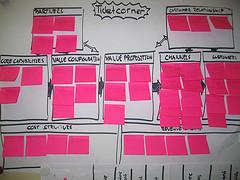 – It must be and be seen. .- Often become leader, but it is not. .- The charisma is personal and not transferable. Convince .-. .- It is an art. .- Believe in action (sudden transformation).
– It must be and be seen. .- Often become leader, but it is not. .- The charisma is personal and not transferable. Convince .-. .- It is an art. .- Believe in action (sudden transformation).
.- The principles wants to enjoy. .- Capacity, effectiveness and ideology. The improvement team should be involved in the process and help its development. Need previous training. Make self-evaluation. The systematic and regular use of the Model by the management team allows it to establish plans for improvement based on objective facts and the achievement of a common vision about the goals to be achieved and the tools to use. That is, its implementation is based on: The deep understanding of the model by all levels of company management. The assessment of the situation the same in each of the areas the European Excellence Model Business, sponsored by the EFQM and the EU Commission, the basis of the European Quality Award, consists of two parts: A set of criteria for business excellence covering all areas of operation of the organization.
A set of rules to evaluate the performance of the organization within each criterion. There are two sets of criteria: The Results (criteria 6 to 9) represent what the organization achieves for each of its stakeholders (customers, employees, society and Investors). Agents (Criteria 1 to 5) are aspects of the management system of the organization. They are the causes of the results. For each group of criteria is a set of rules-based assessment in the “logic Reder” The results show positive trends, compares favorably with the specific aims and results of other organizations, be caused by the approaches of agents and cover all relevant areas.
Officers must have a well founded and integrated approach with other aspects of the management system, its effectiveness has periodically reviewed in order to learn and improve, and they must be deployed and implemented systematically in the operations of the organization. Definitely, as we noted calidad.umh.es, EFQM Excellence model, created in 1988, is based on the following premise: “customer satisfaction, employee satisfaction and a positive impact on society are achieved through leadership in policy and strategy, personnel management an accurate, efficient use of resources and an adequate definition of processes, which ultimately leads to excellence in business performance “is a continuous application model in which each one of its nine elements (criteria) are broken down into a number of sub and can be used independently or jointly. These sub-criteria are evaluated and weighted to determine the progress of the organization towards excellence in the EFQM model is a tool for quality management that enables the organization to guide the client, one of the fruits awareness of the management team and staff for the sake of improving their products and / or services. The base model is the self, understood as a comprehensive and systematic examination of the activities and results of an organization that is compared with a business excellence model (usually a lead agency).